
Herding
70-100 lbs. (male);
60-80 lbs. (female)
22-24 in. (male);
20-22 in. (female)
10-12 years
1. Key Characteristics of Old English Sheepdogs
The Old English Sheepdog — a.k.a. OES, bobtail or Dulux dog — is a strong, square dog with a black nose and eyes in brown or blue, or one of each color.
The ears are medium-sized, and the coat comes in colors of gray, grizzle, blue or blue merle, with and without white markings.
This intelligent and agile breed is commonly known for being the “spokesdog” in advertisements for Dulux paint since 1961 — hence the alternative name “Dulux dog.”
2. Where Old English Sheepdogs Came From
Theories about the Old English Sheepdog’s history vary, but evidence exists that the breed was developed in Devon, Somerset and Cornwall, England.
Contributing breeds included the Scotch Bearded Collie, Russian Owtchar, Poodle, Deerhound, Briard and Bergamesco.
British farmers used the breed to herd sheep and cattle because the dogs didn’t run away or display aggression and were affectionate and agile without being overly hyper. They were also used for retrieving and sledding, as watchdogs, and as companion pets.
A signature of the breed is its gait, said to resemble the shuffle of a bear.
The tails were docked to indicate working status, and the breeding of Old English Sheepdogs with short or missing tails was encouraged in the 1888 breed standard. Tail docking is now illegal unless the dog fulfills a specific working duty.
The first appearance of the Old English Sheepdog in Britain occurred in 1873. In the United States, it was in 1888, the same year the American Kennel Club (AKC) recognized the breed. The American breed club was formed in 1904.

3. How Friendly Are Old English Sheepdogs?
Old English Sheepdogs are athletic, energetic, affectionate and loyal — and, at times, clownish.
They are friendly, intelligent, and adaptable to different situations and environments. They are good with children, enjoy a family environment and can remain in a puppy-like state for years.
These dogs are great around children and seem to thrive in a family environment, but you should expect to train your Old English Sheepdog so they don’t try to herd people. They learn and follow commands but need consistent training.
4. Is This the Right Dog for You?
Exercise Needs
MEDIUM: Regular, daily exercise is necessary for this energetic breed. The dogs enjoy working and need to expel that energy, so playtime and a walk or jog each day should suffice.
They are active indoors and do well in apartments with sufficient exercise.
Grooming Needs
HIGH: The dogs’ coat is coarse and long, and as you may expect, this requires regular grooming.
Brush your Old English Sheepdog a few times a week to reach the thick, waterproof undercoat.
The coat can mat without brushing, and this neglect can lead to parasite or skin problems. Shedding is minimal to average.
An Old English Sheepdog’s nails, teeth and ears all need regular cleaning.
Health Problems
HIGH: The Old English Sheepdog is known to have health problems in the following areas:
- Cerebellar abiotrophy/ataxia, a neurological disease affecting coordination and movement. A genetic test is available to identify if the condition is present.
- Hip dysplasia
- Deafness, commonly seen when breeders cross dogs in an attempt to get mostly white or all-white Old English Sheepdogs
- Seizures
- Cancer
- Heart disease
- Progressive retinal atrophy, cataracts
- Hypoglycemia
- Drug sensitivity
More Stats About Old English Sheepdogs
| Friendliness | ★★★★☆ |
| Ease of Training | ★★★☆☆ |
| Barking/Howling | ★☆☆☆☆ |
| Shedding | ★★☆☆☆ |
| Tolerate Being Alone | ★★☆☆☆ |
| Very Good With Kids | ★★★★☆ |
Say hello to Blue, an Old English Sheepdog at the 2018 Westminster Kennel Club Dog Show:

5. How to Adopt an Old English Sheepdog
Even purebred pets like the Old English Sheepdog can end up in rescues and shelters. Check those out first using our adoptable pet search or local resources.
If you do turn to breeders, ensure they have performed the proper genetic tests on their dogs and do not show signs of being a puppy mill.
References
- “Old English Sheepdog.” American Kennel Club. https://www.akc.org/dog-breeds/old-english-sheepdog/.
- “History of the Old English Sheepdog.” Old English Sheepdog Club of America. http://www.oldenglishsheepdogclubofamerica.org/breed_info/history.php.
- “Information Pamphlet: Old English Sheepdog.” Old English Sheepdog Club of America. 2012. http://www.oldenglishsheepdogclubofamerica.org/pdfs/oescabreedpamplet.pdf.
- Martin, Bob. “Helpful Hints on Grooming the Old English Sheepdog.” Greater London Old English Sheepdog Club. https://www.gloesc.org/petgrooming.htm.








